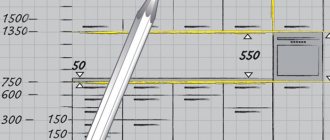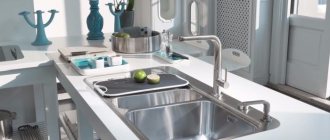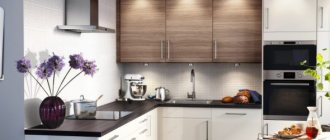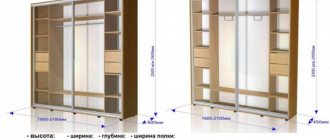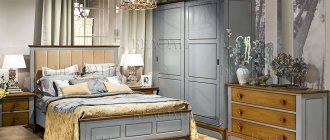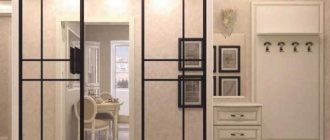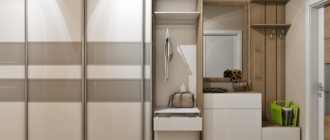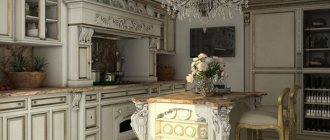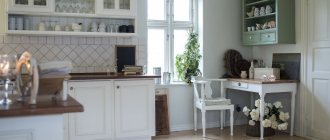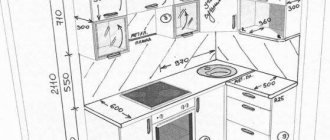Planning a kitchen begins with arranging the main elements and key centers: determining the location of the refrigerator, stove, sink, dining area. If you know the standard sizes of kitchen cabinets and cabinets, then you can make the layout as convenient, functional and... budget-friendly as possible. After all, modules of standard sizes are much cheaper than non-standard ones made to order. And they fully meet the requirements of ergonomics, which have been refined over the years to make the kitchen as comfortable and functional as possible for the housewife.
Cabinet sizes
To correctly calculate and select the size of kitchen cabinets, you need to know some features, as well as what standard size of kitchen cabinets exists. If you have not had to deal with this matter, then of course certain difficulties may arise. First you need to take measurements of the room, calculate the area of the kitchen, measure the place where you plan to install the future kitchen unit. It is advisable to first develop an approximate design of the future kitchen. But in order to do it correctly and accurately, it is imperative to understand what height, width, length are, as well as the correct placement of modular furniture in space.
Many resort to the help of professionals, because knowledgeable specialists in this matter will be able to do everything as needed. A professional will come home himself, take the necessary measurements and select suitable designs. However, even in these cases you will need to know some rules. An outsider may not take into account important nuances - preferences for furniture (built-in or modular), the height of the housewife, the style of the future design of the kitchen, and much more. For this reason, you must first study the rules for calculating kitchen furniture.
Bottom row
When installing cabinets in kitchens, it is worth knowing the parameters of the bottom row. The style of the kitchen space does not matter at all - classic, loft or hi-tech.
The standard dimensions of the bottom row of the kitchen are usually as follows:
- standard height (total) should be 85 cm;
- the height of the base or the height of the lower kitchen cabinets from the floor is 10 cm;
- The depth of the cabinets should be at least 46 cm. If there are drawers, the drawer itself usually takes up 45 cm and 1 is left for free space up to the surface of the rear wall of the modular structure. The most popular depth sizes are from 56 to 58 cm;
- the standard depth or width of the tabletop can have three sizes - 60 cm, 90 cm and 1 meter and 20 cm;
- Tabletop thickness sizes are 28, 30 and 40 mm. This parameter determines the strength and cost of the furniture;
- The level of overhang of the tabletop is 30-50 mm from the front side and 50-100 mm from the back of the cabinets. If we take this margin into account, it will be possible in the future to normally place electrical wiring and pipes that run along the wall surface;
- the size of the width of the facades is from 30 to 40 cm. You should not install furniture with a size of the front width of more than 90 cm, because this will cause severe inconvenience during the operation of the furniture;
- height indicators in the spaces of the internal shelves. These parameters usually range from 20 to 40 centimeters. But they are not considered mandatory; each consumer can select the optimal sizes as desired.
The parameters are closely related, for this reason it is important to strictly adhere to the dimensions, this will help maintain the style and functionality of the kitchen space. The height of the lower kitchen cabinets can be adjusted, for example, using twist-out legs. If you have a tall cabinet, then you can remove the legs from it, and if it is low, then, on the contrary, you can add legs to it to add height. But don’t forget about functionality; it is important that the modular kitchen looks organic. But the size of the cabinets depends on the countertop and its parameters.
It is worth considering the size of the tabletop. Countertops from 60 cm are considered in demand. The depth of kitchen cabinets can be from 46 cm. You should not make a tabletop smaller than this size, because the kitchen requires a large and comfortable work surface on which the necessary food preparation work can be done. With this surface size, you can easily select cabinets for a sink, gas stove, or built-in appliances.
Worktops with dimensions starting from 90 cm are ideal for large kitchen spaces. The depth of the lower cabinets is usually from 76 cm. But countertops with a size of 120 cm are suitable for professional kitchens or for loft-style kitchen spaces. These large surfaces can be used to create an island in a room.
Upper modules
When considering the dimensions of wall kitchen cabinets, it is also worth considering the parameters of the upper modules. This will make the task of choosing much easier, as well as determining at what height to hang kitchen cabinets. To ensure functionality and proper storage of dishes, food and other utensils in the kitchen, you should carefully read the rules for calculating the sizes of the upper modules. This will help you understand at what height to hang kitchen cabinets.
Wall top cabinets usually have the following dimensions:
- the height of the upper cabinets should be from 790 to 900 mm;
- The standard depth of upper cabinets is from 300 mm. If the kitchen has a wide work surface, then the depth will be equal to half of it;
- the distance from the working area (apron area) is at least 450 mm. But for convenience, this indicator can be adjusted to suit growth parameters; it can reach 55-60 cm;
- the size of the width of facades with high upper cabinets must match the parameters of the lower row;
- adjusting the distance to the equipment depends on its type - to the kitchen hood it is usually about 70-75 cm for an electric stove, and for a gas stove - 75-80 cm;
- the permissible height of wall cabinets from floor to ceiling should be 210 cm. A tall cabinet can be larger, two meters 50 cm.
Kitchens with the dimensions indicated above are the most optimal for kitchen spaces in typical high-rise buildings. The main parameters that must be taken into account are the dimensions of the distance from the bottom row to the top shelves; they must be at least 450 mm. This will help you place all the necessary equipment, dishes and kitchen utensils with maximum convenience.
Corner models
Corner models are often installed in this room for storing dishes, utensils, and food in the kitchen. But in order for its installation to be completed successfully, it is worth carefully considering the parameters of this type of furniture. The table below shows the exact calculation scheme for corner models.
| Name | Size (in centimeters) |
| The height of the headset from the floor to the ceiling surface should be standard. | From 180 to 250, the cabinet column will be the highest zone of the headset (almost 250). |
| Depth of upper and lower cabinets. | 30-40 and 46-50 |
| Width of facades. This parameter is usually standard, as with all types of kitchens. | From 30 to 40 |
| Tabletop thickness parameters. It is advisable to choose products with a large thickness, especially for kitchen sinks. | 2, 3, 4 |
| The distance from the working surface can be adjusted to suit you. | It must be at least 46. |
But many professionals recommend choosing the size of a corner kitchen according to your wishes, the main thing is that it is comfortable. Modern models from different manufacturers, for example, Belarusian kitchens ZOV, loft, provide maximum convenience and functionality.
Appliances that influence the choice of kitchen
Example of built-in appliances for kitchen furniture
To get the most optimal design of kitchen furniture, you need to initially decide which built-in appliances will be used now or a little later.
Built-in technology includes:
- washing machine;
– dishwasher;
- fridge;
– hob and oven, or standard stove, etc.
The designer needs to be warned in advance about the dimensions of the built-in appliances chosen for the kitchen.
Location near the stove and refrigerator in a very small kitchen
Location near the stove and refrigerator is not recommended. Because heating will increase the electrical energy consumption of the refrigerator, which can damage it. The distance from the countertop to the refrigerator should also be thought out, because it often gets splashed during the cooking process, which makes cleaning the kitchen more difficult. A distance of at least 15 cm must be provided between the refrigerator and the countertop.
Don't forget about the hood. It has the following placement standards (from it to the hob):
– for an electric stove 70-75 cm;
– for a gas stove 75-80 cm.
Hood on a gas stove for a bright light green kitchen
As for ovens, to ensure quick, trouble-free opening and closing of the door, it must be installed at a distance of 1 cm from other kitchen cabinets. The oven is installed in a pencil case at eye height. This is necessary to ensure comfortable use and so that children cannot reach it.
Built-in oven at a convenient height
How to choose the right size
The size standard for kitchen cabinets is usually designed for typical kitchen spaces. When choosing furniture, you must first measure your kitchen; it is important that the set can be accurately built into the room. But at the same time, the products should not interfere or cause inconvenience. If a column is installed for the kitchen, then the pencil case should not clutter the room and fit into the height dimensions. Of course, if furniture is selected for a loft kitchen, then there are no special difficulties or restrictions when choosing, but for a small room choosing furniture products is much more difficult.
Height
The optimal height from the floor should be an average of 180 to 250 cm. The height of the bottom row should be selected depending on height. On average, it should be about 80-85 cm. When choosing, evaluate the dimensions of the products; they should fit your height. If you hang wall cabinets above the established level, some difficulties may arise. It is important that there is a gap of 46-50 cm between the tabletop of the lower row and the upper cabinets.
The total height of kitchen cabinets should not exceed 250 cm, otherwise the set simply will not fit into the room.
Depth
The depth of the cabinets is an important indicator that ensures complete storage of necessary items in the kitchen. The depth of standard products should be 30-40 cm, deep 50 cm. If desired, you can use a kitchen cabinet with greater depth, the main thing is that it does not clutter the room.
Width
Width standards are usually used in the production of kitchen furniture, for this reason there are no particular difficulties in calculating this parameter. But it’s still worth familiarizing yourself with the detailed details first:
- the width of single-leaf structures ranges from 300 to 500 mm;
- the width of double-leaf products varies from 600 to 1000 mm;
- The width of corner structures is usually made from 900 mm. But the width of the facades is calculated according to the geometric formula of isosceles triangles - it is equal to 130 centimeters;
- the width parameters of the upper cabinets depend on the lower row - on average they range from 30 to 100 cm;
- The width of the facades of the upper corner structures is 85 cm.
Universal formula for calculating height
A standardized product costs less than a product made according to a sketch. The reason is that the client’s individual indicators were not taken into account during design and manufacturing. But the main parameter influencing the height of the kitchen set is the height of the owners.
When designing furniture, the following data is taken into account:
| Human height (m) | Permissible tabletop height (cm) | Depth (cm) |
| Less than 1.5 | 76 | 45 |
| 1,6-1,7 | 85 -90 | 50 |
| 1,7-1,8 | 88-91 | 55 |
| Above 1.8 | ≈ 100 | 60 |
Based on the information presented, a formula for calculating the height of a kitchen unit is proposed:
? = 85 cm ± 5 cm (for every 10 cm of height from the standard of 160 cm)
To prevent a person from experiencing discomfort during the work process, hands should not rise above the waist. You can take measurements at the point of purchase without using special tools. To do this, you need to bend your elbows and measure down 15 cm. This will be the optimal height of the headset for the lower tier.
The upper cabinets will be placed at a distance of 140-150 cm from the floor. The height of the owner is taken into account. It should easily reach the shelves.
Working triangle rule
There are several ideas with which you can arrange all the structures, sink, stove, as well as appliances, so that they provide functionality and maximum convenience. Typically, many stores provide standard size cabinets for the kitchen. But if you arrange them correctly, and also use some ideas for storing kitchen utensils and food in cabinets, then even a small room will look much more advantageous and visually become wider. But it is worth observing some nuances, otherwise you will end up with a cluttered kitchen with a clutter of all kinds of furniture.
It is important when arranging a kitchen space, regardless of its design (loft, hi-tech, classic), to take into account the preferences of the hostess. First of all, special attention should be paid to the work area, because this is where a woman has to spend most of her time. Wardrobes should be hung taking into account the height of the owner, but do not forget about her preferences. The arrangement of modules should be harmonious and convenient.
It is worth highlighting several zones of the work triangle:
- The first and most important area is the working surface. This may include a gas stove, countertop, microwave oven;
- second kitchen area for long-term food storage - freezer, refrigerator;
- clean area - dishes and vegetables are washed in this area. A sink and dishwasher are installed in this area.
If we look at numerous drawings and photos, it becomes clear that the distance between zones should not be more than two arm lengths. From the refrigerator you have to go straight to the sink to rinse the food. After this, you go to the work surface to prepare the food. After finishing the work, you again have to go to the refrigerator to remove the remaining food or a cold dish. When cooking, you often have to go to cabinets where spices, seasonings and other necessary products are stored. For this reason, during installation, as well as when hanging furniture, it is worth calculating everything correctly so that each item is located nearby, but does not interfere with the functionality of this room.
Suspensions, racks and other upper structures should be in height and nearby so that the housewife always has everything at hand.
Tabletop dimensions
Countertops are divided into ready-made ones with and without postforming. A postforming tabletop implies the absence of edge material on the front part of the product. The covering is the original dam of plastic, which envelops the front end of the tabletop along with the working horizontal. It looks reliable and does not allow moisture to get inside the product. Without postforming, the end of the tabletop is processed with a plastic edge. The thickness (height) of the kitchen countertop depends on the manufacturer:
- Imported countertops Duropal, Odyssey (Germany), McMart (Italy) have a thickness of only 38 (40 mm).
- Russian countertops can be 26, 28, 38 mm thick.
The standard width of a kitchen countertop is 600 mm. If a smaller width is needed, then saw off to the desired size yourself. There are tabletops with a width of 800 and 1200 mm. They are used for island kitchens, for integrating countertops into window sills, and for corner kitchens of non-standard sizes. If you need a kitchen countertop depth of 700 mm, then buy a product 800 mm wide and saw it to the required size. The length of the table top is made in the following sizes, mm:
- 3000 (manufacturer Slotex);
- 3050 (manufactured by Kedr, Soyuz, Veroy, Skif);
- 3650 (Cedar, McMart);
- 4050 (Duropal);
- 4100 (Cedar, Duropal, Odysseus);
- 4200 (McMart, Union).
It can be seen that Russian manufacturers produce mainly three-meter products, while importers specialize in countertops 4 meters long.
If the length of the straight kitchen is greater than the length of the countertop, then a joint is inevitable at the junction of the two parts. When calculating the length, pay attention to the technical processing of the tabletop on both sides. A 4200 mm tabletop will be 2-4 cm smaller after cutting the raw edges.
Countertops made of artificial stone are also tied to the standard dimensions of simple countertops in depth. As for thickness and length, the stone has advantages here. The standard thickness is 40 mm, but can be doubled or more. The length is also standard, but due to the peculiarities of stone processing, there will be no joints along the length and angle. In addition, stone is difficult to damage, which is why it is increasingly being chosen when installing a kitchen .
Blueprints
Standard or non-standard?
So, if you are at the planning stage of your future kitchen, then, most likely, you already know that you will have to buy ready-made fronts from some manufacturer that will offer you products of non-standard and standard dimensions. Before we begin calculations and design, let's figure out what the difference between these categories is.
- Fronts of non-standard sizes, that is, according to your calculations - this option allows you to make the most efficient use of the available space, optimize the filling of the kitchen unit and implement non-standard solutions, but the overpayment for “non-standard” will be 25-30%, which is noticeable, especially if you order facades with expensive cladding . Of course, there are also limitations here - one finished facade should not exceed the dimensions of 2520 * 920 mm and be less than 110 * 596 mm. Also keep in mind that “custom” fronts take 3-5 days longer to produce.
- Fronts of standard sizes are preferable to use because, firstly, there is no extra charge, and secondly, because it will be somewhat easier to design a cabinet and select components. In addition, in recent years, manufacturers, following customer demand, have begun to produce standard facades for kitchens with low or very high ceilings, so, more often than not, you can go the “standard way” without losing anything.
Conclusion: it turns out that it is more profitable and easier to draw up a project, adapting as much as possible to the standard dimensions of the fronts, but if necessary, order the production of products of non-standard width/height.
- Why are “non-standards” more expensive than “standards”? The fact is that the production of standard fronts is essentially template-based and does not require reconfiguration of equipment; accordingly, less labor costs and time are required for their production.
The table below shows the standard sizes of blind doors, display cases and drawer fronts.
Standard dimensions of kitchen facades
| Doors are solid | Showcases | Drawers and cabinets | |||
| Height | Width | Height | Width | Height | Width |
| 396 | 496 | 496 | 496 | 140 | 296 |
| 396 | 596 | 596 | 596 | 140 | 346 |
| 570 | 296 | 570 | 296 | 140 | 396 |
| 570 | 346 | 570 | 346 | 140 | 446 |
| 570 | 396 | 570 | 396 | 140 | 496 |
| 570 | 446 | 570 | 446 | 140 | 596 |
| 570 | 496 | 570 | 496 | 283 | 296 |
| 570 | 596 | 570 | 596 | 283 | 346 |
| 713 | 296 | 713 | 296 | 283 | 396 |
| 713 | 346 | 713 | 346 | 283 | 446 |
| 713 | 396 | 713 | 396 | 283 | 496 |
| 713 | 446 | 713 | 446 | 283 | 596 |
| 713 | 496 | 713 | 496 | ||
| 713 | 596 | 713 | 596 | 110 | 596 |
| 900 | 296 | 900 | 296 | ||
| 900 | 346 | 900 | 346 | ||
| 900 | 396 | 900 | 396 | ||
| 900 | 446 | 900 | 446 | ||
| 900 | 496 | 900 | 496 | ||
| 920 | 296 | 920 | 296 | ||
| 920 | 346 | 920 | 346 | ||
| 920 | 396 | 920 | 396 | ||
| 920 | 446 | 920 | 446 | ||
| 920 | 496 | 920 | 496 |
- Attention! Different manufacturers have slightly different standard sizes, so the exact parameters need to be clarified. For example, fronts with a height of 716 mm are often made instead of the 713 mm indicated in the table.
- These dimensions are relevant for any facades: wooden, MDF, chipboard, frame, etc. - after all, the main thing here is to maintain the correct proportions so that the opening and closing and appearance of the cabinets are correct.
